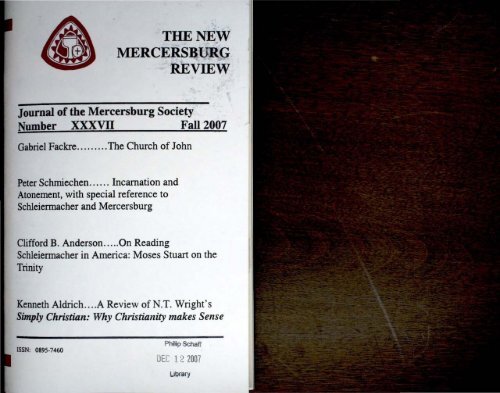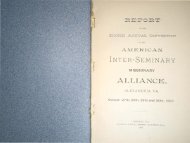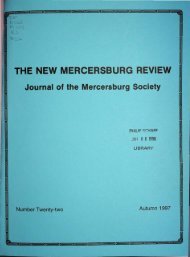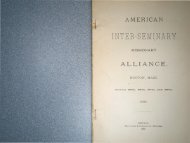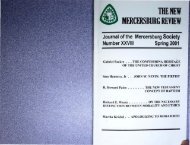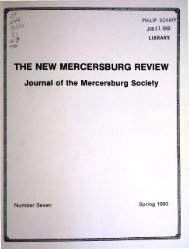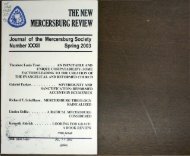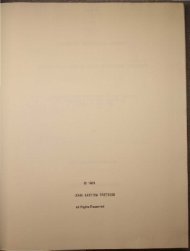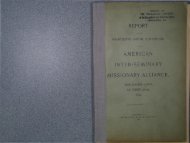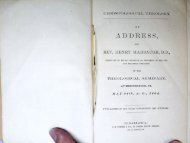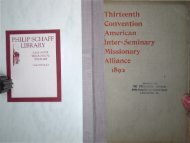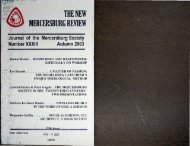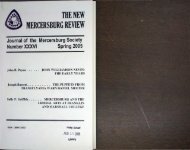Church - DSpace - Lancaster Theological Seminary
Church - DSpace - Lancaster Theological Seminary
Church - DSpace - Lancaster Theological Seminary
- No tags were found...
Create successful ePaper yourself
Turn your PDF publications into a flip-book with our unique Google optimized e-Paper software.
THE NEWMERCERSBURG, 'REVIEWJournal of the Mercersburg SocietyGabriel Fackre"""", The <strong>Church</strong> of JohnPeter Schmiechen " , ... Incarnation andAtonement, with special reference toSchleiermacher and MercersburgClifford B, Anderson ." "On ReadingSchleiermacher in America: Moses Stuart on theTrinityKenneth AldricL "A Review of NT Wright'sSimply Christian: Why Christianity makes SenselSSN: 0195-1460PhIlip SchaffDEC 12 2007l>"""
Biannual Journal of IbeMERCERSBURG SOCIETYThe New Mercersburg Review 37Contributinc EditorsF. Chris Andenon, UCCNorman Kansfietd. RCA (AssisWlt Editor)John Miller. uceLinden DeBie, RCADeborah Rahn aemens, uceGabriel Fackn:, uceJolin B. Payne, uceJosepb Bossett, UUACharles Yrifo~1l, Jr .. UMCHarry Royer, uceTheodore Trost. uceAnne Thayer. uceThe Mercersburg Society has boon formed to uphold the coocepl 01 the<strong>Church</strong> as the Body 01 Christ, Evangelical. Reformed, Catholic, Apostolic,organic, developmental and connectional. "affirms the ecumenicalCreeds as witnesses to its faith and the Eucharist as the liturgical ael lromwtllch all other acts of worship and service emanate.The SocIety pursues contemporary theology in the <strong>Church</strong> and the worldwithin the COflteXi of the Mercersburg tradition. In effecting Its purpose, theSociety provides opportunilies for fellowship and study lor personsInterested In Mercersburg Theology, sponsors an annual convocation,engages in the publication 01 articles and books, stimulates research andcorrespondence among scholars on topics of theology. liturgy. thesacraments and ecumenism.The New Mercersburg Review is designed to publish the proceedings 01the annual convocation as well as other articles on the subjects pertinentto the alms and Interests of the Society.2
From the EditorDuring the past year Jeffrey Roth.lohn Shelter and RHoward Paine have all entered the <strong>Church</strong> Triumphant. They"foffered the~r s~ ial gifts 10 t~e work or The Mercersburg SOC i~ .Y'This issue IS dedicated to theIr memory.We apologize that we have nol had an issue of Th~ NrwMtn:~rsburg Revuw since the Spring issue of 2005. The presentissue promises to be wonh the wait. It contains essays from ourlune 2007 Convocation entitled: "Andover Meets GermanTheology: Two Reformed Cousins, Two Centuries Later" whichtook place at South <strong>Church</strong>. vee in Andover MA.Gabriel Fackre, Ph.D .• preached on "The <strong>Church</strong> of John."If the Roman Catholic <strong>Church</strong> is '"The <strong>Church</strong> of Peter" and theChW'Ch of the Refonnation is ''The <strong>Church</strong> of Paul ," thenMerccr.;burg theologians long for '''The <strong>Church</strong> of John," Dr. Fackreis Abbot Professor of Christian Theology, Emeritus at Andover·Newton <strong>Theological</strong> School in Newton Center, MA. He is author ofa five volume systematic theology that began with the popularChristian StOry.Peter Schmiechen, Ph.D., was President and Professor ofTheology at <strong>Lancaster</strong> <strong>Seminary</strong> from 1985 to 2002. Dr.Schmiechen's latest publication is Salling Power: Theologies of theAtonement and Forms of tile <strong>Church</strong> on Eerdmans. His essayoutlines the importance of understanding the connection betweenincarnation and atonement. From Athenasius and Abelard throughSchleiennacher, Schmiechen demonstrates the significance ofincarnation for Mercersburg.Clifford B. Anderson is the Curator of Special Collectionsal Princeton <strong>Theological</strong> <strong>Seminary</strong>. He received M.Div. fromHarvard Divinity School in 1995. Anderson's discussion of thedoctrine of the Trinily moves from Schleiennacher 10 Moses Sluartto Karl Barth 's work on the Trinity in <strong>Church</strong> Dogmatics/.The Rev. Kenneth Aldrich. O. Min. is a retired Episcopalianpriest living in Huntingdon, PA. His book review compares N.T.Wrighl new book 10 C.S. Lewis' Mere Christidnity.May this colleclion be a blessing to all of us who seek to beEvangelical. Reformed and Catholic.Feast of The Reign of Christ Rev. Dr. F. Christopher Anderson3I
The <strong>Church</strong> of JohnGabriel FackreI Corinthians 12: 14.21,29 John 17: 20-23•. ''The <strong>Church</strong> of John," Folks here will recognize that titleimmediately as fro m the mouth of Mercersburg theologians. Youwill remember they saw the church universal moving over timefrom thc "<strong>Church</strong> of Peter (Rome) through the <strong>Church</strong> of Paul (theRefonnation) to their vision of how things could someday rightly bein the ecumenical "<strong>Church</strong> of John," (While this distinction maywell have gone back to Schelling, they put their own stamp on it.)Thus any future authentic <strong>Church</strong> that embodied theirevangelical catholicity would have to include the best of ''thechurch of hope" (Rome ... and given their writings on the Fathers theEast, Constantinople too), the best of .. the church of faith" (theRefonners). And the lohannine "<strong>Church</strong> or Lovc" would be theculmination that brings those gifts from each into a mutualityreflecting the very triune Life Together that God is. So our muchquoted John 17: 20-21: "that they my all be one, as you Father amin me and I in you ... "But what does all this have to do with this occasion-themeeting of theologians and theologies of Mercersburg andAndover? How can we think them together in any such lovingconjunction when Mercersburgers lambasted the ''Puritans,'' and theAndover missionary bands were more into evangelizing theSandwich Islands rather than catechizing the Pennsylvania anxiousbenchers?Well, could someone who comes from both of thesetraditions preach at an opening Eucharist about such an unlikelymutuality? Maybe someone who was a pastor and teacher in theMercersburg land of the fonner E&R <strong>Church</strong> for 20 years, and thentaught on the Andover Newton faculty for 25 years? Well there arehints of such a lohannine amity in other odd conjunctions. After all,Schaff did give a course of lectures at Andover. And our own HerbDavis did give his whole set of Mercersburg Re}luws to theAndover Newton library. And a carload of pastors from New4
England did make their way 10 New Brunswick in 1983 to helpfound. with Pennsylvania sisters and brothers, this MercersburgSociety. Then the vel)' next year, the Mercenburg Society joinedwith. bunch of New England Tabletalken and the "811." to launchthe Craigville theological colloquies now in their 24th year. (Someof the back-and-forthen are here tonight.) Are these unusualpartnerships portents of what might someday happen in the <strong>Church</strong>of John? .Now in an Andover Eucharist we are from diverse traditionscoming together with Jesus Christ at the Table. And that does makelitis little patch of Christian life together, in some sense, a "churchof John." But let's pursue that small latent unity here and now, andsee what a pMrnt unity in a larger <strong>Church</strong> of John might look likebeyond litis Table. And let's try to do it with the utter honesty thesetwo diverse forebears would expect of us. After all,the great Uniter,Jesus Christ, is a Lord of tough love as well as tender love. And sowere his witnesses at Mercenburg and Andover. None of this"sloppy Agape!"For example, tough talk about this Eucharist itself as in theMercersburg-influenced E&R liturgy:Being of such a sacred nature it is plain that the table of theLord can be rightly approached only by those who are of atruJy devout, repenlant and believing mind. These holymysteries are not for the worldl y, the irreverent or theindifferent ...... not because they are sinners, but becausethey are unrepenlant sinners, not because they are unworthy,but because they eat and drink unworthily not discerning theLord's Table. I~d Andover? Yes, some strange and too stridentdedarallons about who is in and who is out of that 1807 school. Sothe vow of the firsl faculty.I ~ solemnly promise that I will open and explain theScnptures ... in opposition not only to atheists and infidelsbut ! amo~g others] to Jews. Papists Arians, Pelagians,AnllOolUlans Arminians. Socinians, Sabellians. UnitariansJ "Order for Holy CoIIIm . .. Th H1941).21. lIlIJon, e },mMIjSl Louis: Eden Publishing House.Sand Universalists. and to all other heresies which may beopposed to the gospel of Christ and are hazardous to thsouls of men. 1Whew!But inflammatory. rhetoric aside-- and indeed such ternered bfor example. the antHupersessionist cOmmitments of a 1~87 uleGeneral Synod vis-a-vis the Jewish people, or by the Augsbuaccord of 1999 between the so-called "Papists" and World rgLutheranism} - ~ndover 's birth celebrated by us here was a c ftough love--a pamful separation from Harvard in 1807 in orde~ 0train its clergy in the Trinitarian faith. Unity in the <strong>Church</strong> of Jo:whether it's Mercersburg or the original Andover, entailed an n ,ability to say "No!" as well as "Yes!"How different this undentanding of what it takes to have a<strong>Church</strong> of John than so much of today's talk of a unity. Fore~ample , th~ prom?tion here and there of a so-called "open table"With no Christologlcal norms, or a church ... or a seminary, sowedded to the slogan of diversity that a Trinitarian andChristological faith is no longer the framework for diversity! Andhow can we take seriously our own grounding of ecclesial unity inJohn 17:20,21 without keeping in mind the scandalous particularityof John 14:6: "I am the way, the truth and the life and no onecomes to the Father except by me"?This toughness of Agape is eminently clear in our Paulineepistle that should is rightly partnered with tonight's Johanninepassage on unity. Intcrestingly, past-Uec president A very Post.chose these same two lections for his farewell homily at theretirement of Diane Kessler as the splendid leader of theMassachusetts Council of <strong>Church</strong>es three weeks ago in Worcester.And, again. interesti ngly, 1807 Abbot professor Mark Heim chosethe epistle lesson for his baccalaureate sermon at the dedication ofthe new Wilson chapel at Andover Newton two weeks ago. OfCOurse, the lesson for Easter 7 was the passage from John, as well.So such things must be much on our mainline church minds these,In Everell Carleton Herrick. Turns Again lIomt: Ando~tr Nt wlonThtologkal Schoof and ReminiJetnctsfrom
.... ----------------------------....... ~-days. Bul when we hear them p~hed upon, IC,t's listen hard forthe '9udU'Cff of ecclesiaJ love, as In lhe admonitory word of Paul:'"The eye cannot Sly to the hand, I have no need of you ... On thecoouary ...... (1 Cor. 12: 21, 22),Wdl some will recognize this concern about the linkage ofwtmonitotY with hospitality as thai of the note struck in the 1997Formula of Agreement voted on by four nationa1 <strong>Church</strong>es: theElCA, PCUSA, the RCA and the UCC. thaI (onnula featUring thewords. "mutual affirmation and mumal admonition," I rememberthe laIC evening session in 1991 when that language appeared as outof nowhcle after an intense exchange among 6 Refonned and 6Lutheran theologians saying in so many words: there will be nocompromise in litis agreement on the warnings needed to be givenby each to the other. The Reformed are going to accent and offertbcir historic commitment to the divine sovereignty and all that..... ans: "no domesticating deity in the communion elements. norestricting the sovereignty of Christ to the <strong>Church</strong> and diminish.inghis rule over the political, social, and economic terrain. No givingup on the possibilities of sanctificatiQI] in the Christian life or inpublic history. You Lutherans had better pay attention to thesethings in any possible full communion agreement! "And theLutherans, in turn, saying to us: "You people had better listenclearly to our emphasis on the divine solidarity of Christ with hischurch and thus his real presence in the Eucharist. No Zwingliandistancing of Christ from the bread, wine and action will do, nosevering the Head from the Body of Christ. And no forgetting simuliustus et pecCQJor in the Christian life, or the persistence of sin inpublic history, and thus in both cases succumbing to uncriticalassumptions about unfettered growth in self or society." Thesemutual warnings are of a piece with Pauline strictures aboutimperial claims made by the parts of the Body of Christ and thusthe absolute need in any attempts at unity for mutual admonitions aswell as .mutual affirmations.Andjust what about those mutual affirmations'? They toocan be made only by a love that is tough as well as tender. So theLutherans told the UCC when they dropped us out of the ReformedLu~ .dialogue in 1987 because of our perceived theologicalpronuscwty, and then acceded reluctantly to a protracted meeting in7New York in the fall of 1987 with a UCC contingent explainingwhether, and in what sense, this denomi nation might be considereda "confessional <strong>Church</strong>." and on that espoused the doctrillC ofj u stificati~n .~After a~ intense .all-day scs.sion, with RCA andPresbytenan theologians looking on while VCC theologians readpaper.; to ELCA represe~tatives on what their corporately votedpresent texts actually srud, as well as what their historic textsdeClared. most of the Lutherans muttered,. "OK. Come on back in."Then these four traditions resumed their inquiry into what theessentials were which might make mutual affinnation possible.Those wert tough times. and rightly so as these <strong>Church</strong>es workedtoward an update and slight revision of Rupert Meldinius' famous17 ib century aphorism: in essentials. unity-mutual affinnation; inper.;pectives. diversity-mutual admonition; in all things charityanothertrilogy that makes up a <strong>Church</strong> of John. sOn getting clear about the toughness of core affinnations •Ted Trost has it right in a point made in his year-long research ofthe uec "God is Sti ll Speaking" campaign. when he contrasts oneof its slogans that "no matter where you are on life's journey.you're welcome here." with Jesus' own very different posture.proclaiming the coming of the joyful but demanding reign of Godwith its very tough call to repentance.So how do these New Testament passages and their importrelate to this convocation of Mercersburg and Andover'? And more:could what is said here about two streams of Christian history makesome sort of contribution to the wider <strong>Church</strong>?A good case could be made concerning Corinthian mutualadmonition and complementary matters with respect to these twOtraditions. For example, Mercersburg gave high profile to theIncarnation while Andover rang the changes on the Atonement,very different accents. But would one be open to the other? RichardWentt points out in his study of Nevin, that Nevin respo.n~ toDomer's criticism about the lack of the atonement teaching In the• See papers by Louis Gunnernann. Charles_Hambrick.-Stowe and Gabriet Facklein Ntw o,/lvtrsarwns (Winter/Spring, t988). .! The story and substance to be found in Keith F. Niekle and Tlmo~y LU~h eels .•A. Com mOil Collillg: The Wi/lltn o/Our Rt/o"rwtUm Churdui UI NoA.mtrico Todo, (Minneapolis: Aug.sburg Foruess, (993).8
MercenbUrg theology that,for Mercenburg, ''the liturgy was'baptized' in the atoning sacrifice ... bathed in it from beginning toend...6 And. yes, Andover's accent was on the Atonement as thesaving Work of Christ that had to be spre.ad ferven.tly across theoceans. Yet the split of 1807 had to do With the deity of JesusOuist. and therefore a fundamental assumption about theIncarnation. And interestingly. yes. a similar distinction in accents(as in Incarnation and Atonement) occurs regarding ministry.Mercctsburg treats ministry as of the ess~ of the chUIt:h. its verybeing (though not ,of course, ministry in apostolic succession). butAndover in following the Cambridge Platfonn considers it only ofthe bene ~ss~ of the church-only its well-being, giving ecclesialprimacy to the laity as congregation. Yet Mercersburg theologianEmanuel Gerban. for all his emphasis on the office of the pastor,was at pains to assert in detail the "dignity and authority of thelaymen."? Meanwhile. Andover, functionally, from the beginningplaced great stress on the training of clergy and thus sought to avoidthe tendencies of the times to let the spontaneities and enthusiasmsthat swept through the laity to marginalize the learned minister.Accents in one tradition do not preclude openness to those of anecclesial other. Indeed, where there is an ecumenical impulsetoward the <strong>Church</strong> of John, there is a readiness to listen for, andlearn from , them, recognizing that the Body is made up of manyparts and not reducible to one's own historic charism.But before there is any talk of openness to mutualadmonition, there must be, as noted, a foundational mutualaffinnation. That means each party has to be able to recognize inthe other . common core of convictions-- "in essentials, unity." IsthCIe evidence of such? Yes. For one, the common conunitment to aTrinitarian faith, linking both to such a non-negotiable in any widerecwnenism. So too, historic unity on the scandaJ of Christologicalparticularity, so imponant in today's drift in too many placestoward an uncritical pluralism, yet al the same time a place in eachtradition for the premise of their shared hisloric ReformedI Ciud i.a R.ictwd Wentz. John WiUimnson Nevill: Ameriam TheologulII NewrOflc Oxford Universit), Press, 1997), 141.Emanuel Gubart, l fUtitidel of/he Chris/ian Religion, Vol. 2 (New York.; Funk.and. Wignall, 1894), S28.9heritage's assertion ~f a "common grace," preserving though!!.21.saving, a grace that IS able to honor truth, goodness, beauty andholiness wherever found.Yet another commonality that underscores a Reformedcousinship is their mutual affirmation of the three-fold office ofChrist_prophetic, priestly and royal-- that can be found in both the19 110 century Mercenburg theology with its Heidelberg catechismbackground and the Andover theologians' writings grounded inCongregational creeds and platforms, a stress on the munus triplexstill current today, as in the chapten in Scott Paeth's 2006 UCCcollection: Who Do Say That I Am? in essays on the imponanceofthe three-fold office by Andover cum Congregational heir, MaxStackhouse, and Mercenburg cum E&R heritage heir, Lee Barrett'But let's face it. A true <strong>Church</strong> of Love, the ultimate incatholicity, would entai l both Mercersburg and Andover movingbeyond their own, finally, tiny constituencies. Such anencompassing <strong>Church</strong> of John would have to include most of therest of Christendom . That would mean the billion plus of Rome andConstantinople-the <strong>Church</strong> of Hope, and, perhaps even morechallenging, some parts of the <strong>Church</strong> of Faith that seem strange toold-line Reformation <strong>Church</strong>es-- the pentecostal and evangelicalfires and fevers of the global south which, Phillip Jenkins tells us, iswhere the majority of Christian believers will someday be in the21" century. Any kind of future <strong>Church</strong> of Love will have to cometo lenns with these two multitudes. Can a sacramental Mercersburghave anything to do with these evangelical and Pentecostaleffervescences? Can an Andover tradition of congregationalautonomy have anything to do with apostolic succession? Or makeit even harder by tuming the question around: can a Ratzinger who• See Max Stackhouse, ''The Officc s ofctuiSI from EartyCburch Through theReformen," and Lee Barrell, "ChrislOlogy in the English and ContinentalReformations," both in Scot! Paeth . ed., Who Do You Sa, [am? Chm/olo,,_lUn4ly ill the United <strong>Church</strong> o/Christ (Clevetand: United. <strong>Church</strong> Press, 20(6),2.5-41 .nd 42-6j. My own eUI)' in the same book also deals with the ~us .rriplu. Indeed, l UCC theologian who has worked 01l1xKh s!des. of~ histonetraditions has written an entire volume on it. indeed, connecung It WIth theTrinitarian core to whieh earlier reference was made, Robert Sherman, lUng,PrieS/lind Prophet (New York: T &T Clark: internalional. 2(04) ..10
DOC 10 long ago bewailed a neo-c:ongregationalism he felt wasm,king imowts into his own <strong>Church</strong> have anything to do withAndovct and its heirs?9 Or can Pentecostals aflame with their faithhave anything 10 do wid! what they consider are the old-lineOIurch', dying embers of rites and rituals? All this seems to maketalk of a <strong>Church</strong> of John well beyond the borders of Mercersburgand Andover sheer utopianism. I expect that is so in my time and nodoubt in all of yours as well. But wait a minute. What are we tomake of these recent remarks of Cardinal Walter Kasper?The Catholic <strong>Church</strong> is ... wounded by the divisions ofChristianity .... Several aspects of being church are betterrealized in other churches. So we can learn from each otherin order to grow in the one truth of Jesus Christ. ... Thussince the Council we Catholics learned a lot from ourProtestant brothers and sisters about the importance of theword of God and its proclamation ... The oikoumene is notabout a way backwards but about a way forwards by mutualexchange ... Ecumenism is no one-way street, but areciprocal learning process-as stated in the Encyclical Urunum sint-an exchange of gifts. 10Now, how about that? And Cardinal Kasper walked the walk aswell as talked the talk because he was instrumental in bringing to bethe accord between Lutherans and Roman Catholics on the doctrineof justification, something of that miracle of mutuality, indeedprecisely one that had in it both mutual affinnations and mutuaJadmonitions. 11If a cardinal of Rome, indeed, its ecumenical officer, cana.::knowledge his own <strong>Church</strong>'s need to listen to the ecclesial"other," and learn from it, how dare we not do the same? Especiallythe heirs of Mercersburg that dreamed of that <strong>Church</strong> of love t belAnd the same thing is the case if we are to go by the 200dl o.anniversary professedly ecumenical heirs of Andover seminary'Just so, ho~ dare we ~~t look for the day of the <strong>Church</strong> of John .with its 10Vlng mutuahlles of affinnation and admonition. And setup signs here and now on the path toward it? And to make such asign, to the Table together we go to be with the Christ who prays tothe Father for that day when we shall all be one.Amen'J
Incamalion and Atonement, with specialreference to Scbleiennacber and MercersburgPeter SchmiechenThis discussion of atonement and incarnation will focus onsevcnl themeS: First, the need to change the way v:e ~ink about.atonement. The conventional wisdom is that there IS ~Ither one bIgtheory of atonement (penal substitution) or three ~eon~ named byGustaf Auten in his landmark book of 1931 : Christus VKtor. Aswe shall see, both of lhese options present us with serious problems.The most serious is that they restrict our vision of lhe many ways inwhich the saving power of God in Christ meets human need. TheNew Tes"ment and Christian traditions offer us a far richer set ofimages and theories.Second, I want to explore the relation of atonement andincarnation. It is my contention that the witnesses to saving powerin Christ make clear that incarnation is the inevitable and necessaryconsequence. Moreover, once this conclusion is reached, thetheological affinnation of incarnation begins t~ f~nction as ~presupposition for what may be called the Christian re-thmking of, God, human life, sin and salvation, and Ihe redeemed life.Both of these interests relate directly to Mercersburg.Unless we expand our view of atonement, there is no considerationof the view of Christ in the Mercersburg tradition. It was thedistinctive genius of Mercersburg 10 lake as ils starting point theincarnation and the new life Christ initiates. While its view ofatonement includes forgiveness of sins, the conquest of demonicpower and the demonstration of divine love, il shifts the emphasis10 participation in the spiriluallife which enlivens the church as theBody of Chrisl In order 10· see the distinctive character ofMercersburg's approach 10 atonement. we need to expand the entireframework for understanding atonement.In a related way. Mercersburg becomes a wonderfulexample of a theological tradition that takes incarnation as itsstarting point and treats atonement and incarnation as inseparable.When we explore Mercersburg from this perspective. it will not13surprise us that its lin~age tak:s us back to t~ree other theologicalfigures who also take incarnatIon as the slanlng point Athanasius.Anselm and Schleiennacher.1. Rethinking AlonememLet us begin with the standard options regarding atonement:either there is one theory or the three outlined by Gustaf Aulen. Ifthe only theory is that of penal substitution, we are in serioustrouble, in spite of its elevation by so many to a position ofdoCtrinal inerrancy. It is flawed for two reasons: Firsl, it makesGod into a passive, angry deity. waiting for the scales of retributivejustice to be balanced by the death of the innocent Jesus in paymentfor the sins of the world. Second, it isolates the death of Jesus andmakes it inlo something of intrinsic value demanded by God. It isvery difficult 10 find this view in the teaching of Jesus or elsewherein the Bible, where salvation is always presented as the action of agracious God to redeem fallen humanity. Now it may welJ be thatwhile many affirm penal substitution. they do not necessarilysubscribe to the rigorous version of Charles Hodge. wherepunishment must precede forgiveness. or even the bloody version ofMel Gibson '5 The Passion of Christ. It is quite possible that manyhold a softer version, wishing to affirm that Jesus died for me and inmy place, or that I am redeemed by his life and death.Nevertheless. the theory of penal substitution violates so many ofour evangelical and theological values that it is difficult to endorse.But things do not get better in Aulen's proposal that thereare three theories: a transactional view linked to Anselm, asubjective view tied to Abelard, and a c1as sic~ vi~w ~amedChristus Victor. The transactiona1 or pena1 VIew IS reJecled by. d .Aulen for reasons already noted. But Aulen alsobeJU ges It toPelagian since it is the human Jesus who offers his life to God.This human•act is repeated ever afler by fruthful. bel·levers. theInRoman Mass, as a work lifted up to God to earn our s alv ati~n. Thesubjecli ve view is rejecled because nothing really happens In theworld except for a declaration of God's love, given solel~ to changeour h"""~ To p"'phrase Aulen, the entire gospel story IS thus........,. . h u werereduced to a postcard from heaven: ''God loves you, WlS yohere. Love, God." Having rejected these twO views, Aulen then14
_ .. whal he calls the classic view, running from Paul throughI ayslN' .. Ch ' ,lrenICUS to Luther. wherein the Vlctonous nSI conquers sm,
twucd aside flow the divine purpose or is unable to achieve it. ButwhaI is to be done? Anselm lays out two options: satisfaction maybe IIehiewd by eitMr pJUlishmenJ or restoration. While it appearsthat these two options are equally possible, we soon discover thatfOt" Anselm there really is no choice: God must restore the creation.This is the crucial point in the entire treatise and it leads totwo conclusions:a) if utisfaction must take the form of restoration, then we are ledto the incarnation, which makes possible the liberation of humanityfrom death, the overthrow of the devi l, the restoration of thecreation as well as the honor of God. Any thought of punishmentleading to penal substitution is completely set aside.b) While we may think Anselm made the right choice, he musl paya price that even he does not acknowledge. Recall that Anselmsaid II the oulSet that he would justify the incarnation withoutappealing to the Bible and instead search for a necessary reason forthe incarnation. But the only way he can justify the choice ofrestoration is to appeal 10 God's faithfulness 10 God's own purpose,found in the Biblical record. What we have then is a brilliantaffinnation of the faithfulness of God, but also an admission thatthe search for a principle of necessity acceptable to independentreason ends in failure. Before moving on, let us summarize thisfinl argument: Anselm's whole thesis is construcied around theidea of God fulfilling lhe divine purpose by means of restoration,rather than punishment for violation of the law. Anselm is clearlyworlQng in a framework far distant from that of penaJ substitution.The second reason penal substitution is not a part ofAnselm's view is that at no point in the text does God demand thedeath of Jesus. What Anselm says is that in his obedience andholiness, Jesus freely gives his life 10 God and thereby sets anexample for believers. (Cf. John 15: 13) There is no necessity laidon Jesus by God (or, to employ the intra.Trinitarian tenninology, bythe Father upon the Son). Instead, Jesus' journey toward Jerusalemis of his own free will and love of God. What is made abundantlyclear is that if Jesus dies, it not to satisfy the justice of God as aj uri~ C al requirement, bUI his death is a consequence of hisobedience and love of God.. Bear in mind thai Anselm was a monk,17for whom the vow of obedience was by far the highest goaJ for theChristian-yes, even more important than poverty and celibacy.The Ihird point has to do with Aulen's charge ofPelagianism against Anselm. Aulen introduces a principle whichmost would readily accepl: There must be tala) continuity betweenthe action of God and the aClion of redemption. In applying this toAnselm, Aulen argues that since satisfaction must be accomplishedby humans, therefore when the God-human appears for oursalvation, he is acting only as human. Aulen judges this to bePelagian and represents a discontinuity in the flow of action fromGod {Q salvation. While this argument is parallel to the Reformers'critique of the Roman Mass. il is somewhat out of context whenapplied to Anselm. Anselm's whole point is to argue that theincarnation must occur because humanity can nol offer satisfactionbut only God can. Thus while it is true thai humanilY must offersatisfacti on, it is only the God·human who can. To attribute aPelagian twist to the requirement of the Savior's humanity is 10 doviolence to the delicate logic of incarnational theology found inNicea and Chalcedon. Moreover, using Aulen' s logic, mosttheories of atonement would fai l his test, since in every one thework of salvation is effected by the One who is both divine andhuman. Time and again theology has affirmed thai Jesus is thetruly human one, the new or second Adam, who embodies the trueobedience and love of God. Indeed, for the human nOllO beinvolved would be docetic at worst, or Apollinarian at best.To this point I have argued against only one half of Aulen'sreading of theology. Is it possible that we can aJso retrieve Abelardfrom Aulen's scrnpheap of bad theology? lei us risk the auemptAulen dismisses Abelard as affinning Jesus as a teacher andexample of love, the exponenl of the subjectiv~ view. N?r c~ .hefind anything special about the death of Jesus m Abelard s wotmg.To overturn this caricature of Abelard, one need only read therelevant lexts. Abelard, like Anselm, refuses to build a case for theincarnation and passion of Christ on the basis of negotiations withthe devil. The devil is a liar and God owes the devil nothing. ButAbelard turns his razor sharp logic on Anselm as well: it is n~1 .necessary 10 develop an elabornle theory in search of some pnnclpleof necessity for the incarnation and crucifixion. If in the end the18
the world. For Schleiennacher, Nevin's church questionwas given a resounding affinnalive answer. In and throughthe chwch we participate in the new life God gives in JesusQuist.There can be linIe doubt thaI the Mercersburg theologiansfound in Schleiennacher support for the ideas that religion is aliving reality which develops and lhat Jesus Christ is the bearer ofnew life. But while these connections are clear, they andSchleiennacher stood in a larger tradition going back to Athanasiusand ultimately the Johannine witness to Christ. When this isunderstood, we can then see that there is indeed a way of thinkingabout the cross which is governed by the incarnation. It focuses onGod's will to ttdeem the world by means of the incarnate Word,whereby life is bestowed upon the world through the redemptionembodied in Jesus Chris!. Such an approach to atonement isoverlooked by both Protestants and Catholics if they arepreoccupied with the forgiveness of sins (or its liberal formulation8$ the affirmation of unconditional love). For Mercersburg, theforgiveness of sins is taken up into a larger affinnation of life in theface of death, of the sacramental community of Christ whichtransforms the world, and finally, the on going revealing of God'spurposes.APPENDIX I.o1J11JNE: THEORIES OF ATONEf\.ffiNTA. CHRlST DIED FOR OUR SINS (FORGIVENESS)I. Sacrifice: The Jewish image of sacrifice for sin (i .e.,removaVpurification) and its application to Jesus. TheLetter 10 the Hebrews2. Justification by grace: the righteousness of God revealedapart from the law. Luther's Commentary on Romans3. Penal Substitution: Christ in our Place: Jesus's death ascompensation to the justice of God. Charles HodgeB. UBERATION FROM SIN. DEATH AND DEMONICPOWERS4. Liberation: Christ the Saving Power of God. Irenaeus,Moltmann, Cone, Gutierl'ez, and FeminlstIWomanistTheologyC. TIlE PURPOSES OF GOD5. Renewal of the Creation: Incarnation and New Life inChrist. Athanasius and the Nicene Theology6. Restoration of the Creation by the Incarnation of God:The fai thfulness of God Anselm7. The Completion of the Creation in Jesus Christ JesusChrist the Redeemer. Schleiel'macherD. RECONCDJA TION8. The Destruction of Idols and the True Knowledge ofGod. H. R. Niebuhr2l9. Christ the Reconciler: The cross as God's reconciliationin the face of spiritual warfare. I Corinthians 1-224
10. The Wondrous Love of God. Jesus Christ as aDemonstration of Love and the new community of love.Abelard, Wesley and Mollmann on God's co·sutrertnl·II. The Unveiling of Violence: The Cross as God'sJudgment against institutionalized violence (scapegoating).Girard, Bartlett. HeimOn Reading Schlelermacher In America:Moses Stuart on the TrinityUClifford B. AndersonThe story of Moses Stuart's translation of FriedrichSchleiermacher's controversial 1822 essay on the Trinity provides awindoW intO a fascinating debate which raged in the first quarter ofthe nineteenth century and which concerned the limits of ourknowledge of the nature of God. What led Moses Stuart. a defenderof the doclrine of the Trinity during the Unitarian Controversy inNew England. to translate Schleiermacher's "On the Discrepancybetween the Sabellian and Athanasian Method of Representing theDoctrine of the Trinity,,? IJ On its face the translation and publishingof Schleiermacher's essay hardly seems like a good way to defendthe Trinity. After all, Schleiermacher is frequently classified as anAnti-Trinitarian theologian. The purpose of this essay is to eltplainthe historical circumstances which prompted Stuart to enlist thiscritic of the orthodox. formulation to defend Trinitarian doctrineagainst Unitarian criticisms.The background to Moses Stuart's reading ofSchleiermacher on the Trinity is, of course, the UnitarianControversy in the early nineteenth century. Moses Stuart was aspectator to most of the events in the fi rst stage of the controversy.S~uart was born a Connecticut Yankee in 1780. 14 He grew up on thekind of hardscrabble farm that produced the stone walls which nowrun fo~ l ornly t~oughou t the woods of New England. He showedearly Interest In theology, reading Jonathan Edwards' On The25II !hiMAon ~= ~dete r~ ~~klhe McrcetSbw-g Society Colloquiwn at Andover,kind invita tio~ to lak· wouI e 10 thank the organizers ofilia! event for their1) .. e pan.FnedrlCh Schleiennachtr ·'On the D'and Athanasian Method orR . . th '5Cre?ancy between me SabellianMOSt$ S, , . cpresentmg e Doctnne of the Trinily·· trlll1$ b14 ~b~: Blbllt;~1 R ~pository 5 (1835):265·353; 6 (1836): j.116 . Yw' IOgraphlcal'nformation in th·s h· .. Andrew Hoffecker ··Sl"~" M " '. parngrap IS drawn largely from'"_~ , """. OSC$, A.mencan N,,' lB·J\ "... University Press, 1999) and Edwards Amasa II 10 1lQ I~g,aphy (Oxford:Park, A DlScouut! Ddi~l!lredO'III the Funeral of Pro/cuo, MoSt!s SIIUlI1 (B26 Oston: Tappan & Whittemore. 1852).
Fn~dom of 1M Will (I754) as a child of twelve. IS His linguisticabilities also became manifest early. "While punuing the Latin andme GIL~l. he attended also to the French classics. Several of hiselder schoolmates had devoted many weeks to the reading ofTelemachus. TIley ridiculed him for his attempt to recite with themat me very beginning of his study. He remained with them a dayand • half, and was then transferred to a higher class."loS He enrolledat Yale College in 1797 and graduated two yean later. A religiousconversion led him to give up a planned career in Jaw for theministry. Sroan became a disciple of Timothy Dwight. president ofYale College and grandson of Ionathan Edwards. Dwight conducteda religious revival at the college during the Second GreatAwakening. He sought particularly to defend creedal Christianityagainst Ieffersonian Deism. 17Stuart absorbed Dwighl's NewDivinity as well as his hostility toward Deism and theEnlightenment. He dated his conversion to 1803. 18 Marrying in1805 and leaving his position as a Mor at Yale, Stuart stayed withinthe orbit of Dwight'S influence, becoming the associate pastor andthen pastor of the Center Congregational <strong>Church</strong> in New Haven.While Stuart was preaching Dwight's form of evangelicalCalvinism in New Haven, the struggle over the succession to theHollis professorship of divinity at Harvard College was in fullswing. The Corporation's election in early 1805 of the liberal HenryWare to the Hollis chair (by a single vote margin!) signaled thedefeat of the Calvinist party at Harvard..19 The establishment of the<strong>Theological</strong> Institution in Phillips Academy in 1807 was theorthodox response. The circumstances of its birth were rathercomplex. The Associate Statutes arising from the negotiations 20between the old Calvinists at Andover and the Hopkinsian15 Park. A Disco .. m: Delivered allhe FlIMral of Prof us or Moses StUllrr, 16.16 Ibid.17 a . Conrad CherTy. ''NatUfe and the Republic: The New HavenTheology," 'The New & gland QlUlrrerly, 51 (1978): 510.Ig Park. Disco .. rst. 22.19 John H. Giltner. '"The Frlgmenll.tion of New EnglandCongregationa.li$m and the Founding of Andover <strong>Seminary</strong>," }o .. maJ ofRdigiou.s TIw",ht 20 (1963-1964): 34f.20 On the negotiations themselves. sec: Richard O. Price. ''The LegalAspc
criticism Iibenrec.t the Bible from its scholastic interpretation andenriched his and his students' faith.27Meanwhile, William Ellery Channing was about to initialethe next., decisive phase of the controversy. Channing was born in1780 and gn:w up in Newport, Rhode Island. His neighbor wasSunucl Hopkins, the "foremost proponent of 'New Light' Calvinismof his generation."l1 Channing rejected the revivalist excesses of hisperiod. preferring a more rationalistic, moralistic, and humanisticfonn of Christianity. In 1803. he became the settled pastor of theFederal Street <strong>Church</strong> (later the Arlington Street <strong>Church</strong>) inBoston. 19 Over the next decade, he quietly developed a reputationas a leading liberal intellectual in congregational churches.Ironically. it was Jedidiah Morse of Andover <strong>Seminary</strong> who forcedhim to take a more public role in the Unitarian-TrinitarianControversy. "Early in 1815 Morse exploded a real bomb, byfinancing the publication of American Unitarianism, which wasreviewed in Panoplist of June, 181S.,,](l Channing regarded Ihecharges pUI forward as scwrilous and responded with an opendeclaration of the convictions of liberal Christianity.In 1819, Channing delivered the sermon that catalyzed theincipient division of congregational churches. Gary Dorrien notesthat whereas liberal Congregationalists had generally avoided thetenn 'Unitarian' prior to 1819, Channing now "resolved that theyshould wear it proudly.'.J L According to Earl Morse Wilbur, "thesermon. which lasted an hour and a half, made a profoundimpression at the time, and has probably had a wider. deeper andmore lasting influence than any other ever preached in America."n27 See ibid., 37(.28 Gary Dorrien, The Making of AlfwiCDn Liberal TMDlogy: ImaginingProgressille ReUgiots. /805- /900 (Louisville: Westminster John Knox, 200 1), 6.29 Daniel Walker Howe, ''Channing, William Ellery," Am ~ ricull NationalBiography (Oxford: Oxford University Press. 1999).30 Sidney E. Mead. "Lyman Beecher and Connecticut Orthodoxy'sCampaign againsllhe Unitarians, 1819· t826." <strong>Church</strong> H~tory 9 (1940): 219·220.31 Gary Dorrien, Mukillg of ArMricUII Ubuul Thwlogy. 28. .32 Eatl Morse Wilbur. A H~/Qry of Unuurlanism in TrtlllS)'/vu"'ll. Englund.and Amt!rica (Cambridge: Harvard Universily Pre$s, 1952). 424.29Channing's sermon has rightly ~n called the '~fest.o")) of. theUnitarian movement in the ~mted SI~teS. He diVJ~ hiS te~1 mtomain parts. First, he aruculated hiS understanding of scnpluraitwO f · th· . fhermeneutics, highlighting the role 0 ~n In e I~terpretallon ath Bible. Channing rejected the nOllon thai the Bible should bein~erpreted differentl.y fro~ othe~ litc:rary works .. "O~ leading. cip)e in interpretmg Scnpture IS thiS, that the Bible IS a bookpno f dh· ..wrilten for men, in the language 0 men, an I at Its meamng IS tobe sought in the same manner. as that of ~th~r ~ks.":W C~anninginsisted on the centrality of reason 10 all blbhcal mterpretallon. ~orhim, being rational meant to "distrust every interpretation. W.hldl'after deliberate attention, seems repugnant to any estabhshedtruth.',3j After presenting his hermeneutic, he turned his attention tofive areas of Christian doctrine and practice where he judged theorthodox position to be rationally insupportable: the Triunity ofGod. Chalcedonian christo)ogy, the Augustinian doctrine ofelection, substitutionary atonement, and religious revivalism.Channing put forward multiple arguments against theTriunity of God. On the one hand, he contended that the doctrine isnot scriptural. "We are astonished, that any man can read the NewTestament, and avoid the conviction, that the Father alone isGoo.',)6 Early Ctuistianity, so freshly sprung from Judaism, couldnot have abided any thought of division within God. Trinitarianlanguage in the creeds plastered over the absence of such languagein Scripture. ' On the other hand, he argued that the doctrineinevitably led the untutored to tritheism.When we attempt to conceive of three Gods, we can donothing more, than represent to ourselves three agents.distinguished from each other by similar marks andpeculiarities to those, which separate the persons of theTrinity; and when common Christians hear these personsspoken of as conversing with each other, loving each other,and perfonning different acts, how can they help regarding33 DomeD, Making of ArMrican l.ib~ml Th~%gy. 3S.34 William Ellery Channing, A S~nnOll Ddin red at th~ Ordinatian oJtheRev. Jur~d Sparks. 2'" ed. (Baltimore: J. Robill$On, 1819). S.3S Ibid .. 8.36 Ibid., IS.30
them as ditreaefl.l beings, different minds?'This proclivity to lritheism became evident in orthodox Christianworship, which diluted genuine piety by distracting the worshiperwith a maudlin drama taking place between the divine persons. Hecompared the Calvinist "worship of a bleeding, suffering God" tothe Roman Catholic veneration of the Virgin Mary.18 Channing'sUnitarians would worship an austere and rational Divinity.Channing's sermon galvanized forces on both sides. 'TheBaltimore sermon ignited a firestonn of controversy and madcChanning famous," writes Dorrien. '1t inspired a critical mass ofpaston to stop equivocating about their liberalism. Itsimultaneously horrified and gratified conservatives, who at leastwere finally given the satisfaction of confronting an openly declaredenemy."J9 Two theologically significant responses came fromAndover and Princeton. Moses Stuart of Andover and SamuelMiller of Princeton <strong>Seminary</strong> both penned "letters" againstChanning and his Unitarianism. However, their responses wound upexposing a rift between these centers of orthodoxy.Moses Stuart was among the first to respond to Channing'sprovocations. In 1819, he published Letters to the Rev. WM. E.Channing. 40 He reslricted his apology for orthodoxy 10 theprinciples of Scriptural interpretation, the doclrine of the Trinity.and christology. Stuart wrote in a conciliatory fashion. He impliedthat Channing had failed to understand orthodoxy; if he had graspedthe genuine meaning of its doctrines, he would not have put forwardsuch crude arguments against them. However. Stuart also concededthat the failure of understanding could not simply be chalked up toChanning's ineptitude. The history of doctrinal development hadcontributed to the kind of misunderstanding at the root of hiscriticisms. Stuart felt this particularly true in the case of Trinitariandogma.Surprisingly, Stuart opened his Letters by expressing hisgeneral agICement with Channing's henneneutic. He agreed that the31 Ibid., 14-15.38 Ibid .. 19.39 Ovy Dorrien. Making of American Liberal Theology, 35.40 Moses Stuart. !.etten,o Ihe Rev. WM. E. Channing (Andover: Flagg andGould. 1819).31. to be interpreted historically. "Of course. the l~guage ~fSible had. .nte reted by the same laws, so far as philology ISthe Bible IS to be I rp h book .... Stuart was not about tome.d, as that of any at er .. . .conce di . de between historical critiCIsm, properly exercised,a11~W:~nalVl orthodoXY, properly interpret~ . ,He described the'" ~'wcen his position and Channing s as more aboutdifference . "" . h -" h"'''~n "'ontent As John H. Giltner as"colounngnot"",. owever,u ....•,,"... H Whde--'",mated his disagreement WIthStuart un ,.....,Chanmng.. ereas f" --orded reason the right to evaluate and fCJect aspects 0Channmg......._-'b"bl" aI record al odds with common sense, Stuart adoptcu athe lie I .... I [fiversion of the old mottojides quarens intel ectum : u.,e so e 0 Ice[ ason in res ..... rt to [the Scriptures] is to act as an Interpreter ofo re r- . I ."' S • f"1 ,revelation, and not in any case as a legIS a,?r. . tu~s ~ u~ 0rceive how wide the gap had become at thiS pomt nusled hIm Intothat their disagreement was simply about the relation~nkingbetween biblical criticism and docuinal theology.In his second letter, Stuart complained that Channing hadput forward a caricature of Trinitarian doctrine. If the orthodoxposition really was that the three persons in the Godhead had threedistinct consciousnesses, it would amount to tritheism. "But Icannot help feeling," Stuart politely opined, "that you have madeneither an impartial, nor a correct statement of what we believe. andwhat we are accustomed 10 teach and defend."'" Channing's mistakewas to interpret the concept of person in Trinitarian docuine "in itsordinary acceptation as applied to men: .4' Stuart argued that"person" designated only "a real distinction in the Godhead," not"independent. conscious beings ... :.46 Introducing a term so liable tomisunderstanding into theology had been a mi stake. "I couldheartily wish ... that the word person never had come into theSymbols of the <strong>Church</strong>es. because it has been the occasion of so41 Ibid. xx,' 1 ••S"~~J,""'P' MOlu Sruart: The FOlirer of Biblical Scierl(:t i'l Amuica (Atlanta."'" 111$ le$S, 1988) 60 ... ' 3 Stuan, !.erlef$ 10 I~ R~v . WM. E. ChatlnlM, "~ " d " ~J ., •.., .45 Ibid., 22.46 Ibid., 34.32
much unnecessary dispute and diffieul ,047~~ti~.led its ability 10 define the co~~ept ;fn::~i~~~OO~"diSti~~:a~ :::)1 allow ~ sto assel1 that there is a threefoldpos'ti bo ~~d, . they do not allow us to say anythingI ve. a ~t that disltnctlon. Stuan drew an analoNewtoman science to warrant his agn",ticism '00 t ,... ,&Y ~romTri '( J .. U ute lnmunentm y. USI as. we do not doubt the existence of gravity because we~ only e~~ne~ce. but not define it, so too should we accept theact that distmctlons exist in the Godhead even though we cannotdefine them.Fatefully, SlUart c~ticizedthe Nicene-Constantinopolitan:~ (381) f~r ov~rsteppmg the boundaries of divine revelation.A shght conslderauon of the Nicene Creed nright lead one perhapsto suppose, that undefinable, or objectionable tenns of illustrationhad been, almost intentionally. accumulated in it.'.4tI He consideredth":' ~e Nicene Fathers had overreached when defending againstAriarusm and that the Council of Constantinople had compoundedthe damage when expanding the Creed to exclude Sabellians. Stuartdid not disagree with the intention of the Creed, but he could notsubscribe to its metaphysics. "Patient investigation and candor willlead one to believe, as it seems to me, that the thing aimed at was,in substance, to assert the idea of a distinction in the Godhead. Todo this with the more success, as they imagined. they endeavouredto describe affirmatively the nature of that distinction. Here theyhave all failed.,,049 Stuart pointed in particular to the eternalgeneration of the Son as a concept about which he was ''unable toconceive any definite meaning."soThe generation or production of the Son of God, as divine,as really and truly God, seems to be out of question ... unlessit be an express doctrine of Revelation; which is so far frombeing the case, that 1 conceive the contrary is plainly taught.If the phrase eternal generation then, is to be vindicated. it isonly on the ground that it is figuratively used. to describe anundefinable connexion and discrimination between Father47 Ibid."Ibid .. 41.49 Ibid., 44.5. Ibid .• 41.3l•and Son, which is from everlasting. It is not well chosenhowever, for this purpose because it necessarily, even in i~figurative use, carries along with it an idea. which is atvariance with the self-eltistence and independence of Christ.as divine; and of course, in so far as it does this. it seems todetract from his real divinity.s.SlUart was adopting a risky strategy. He was willing to concede thatcreedal Trinitarian orthodoxy was in some respects flawed in orderto win the confidence of his opponents. He advised those whofound such definitions off-putting to look away from the form to thesubstance, where they would discover widespread agrec:mentthroughout the history of Christianity about "the idea of adistinction in the Godhead:,S2 The presence of a distinction in theGodhead, however indefinable. was scriptural. Stuart seemed toqualify his agreement with Channing'S principles of scripturalinterpretation when he complained that the Unitarians' adherence to'common sense,' which led them to reject something quite obviouslyrevealed in Scripture, elevated reason above reveiation. SJ A morecircumspect reading of the relation between creedal orthodoxy andthe scriptural witness to the Trinunity of God would admit that the<strong>Church</strong> Fathers had gone beyond the limits of revelation whentrying to ward off heresy. Stuart had "no attachment" to the"technical terms" of creedal Trinitiarian doctrine and could even''wish they were, by general consent, entirely exploded.,,$04However, he vowed to defend the "things which are aimed at bythese terms," adding that "logomachy is too trifling for a lover oftruth:"sStuart's defense of the substance but not the fonn oftrinitarian doctrine raised eyebrows in orthodox camps. Among~ose who chastised him for making too many accommodations to~ s opponents was the Princeton <strong>Seminary</strong> professor of churchhistory. Samuel Miller (l769-1850). Miller resented the incursion"Ibid .• 42.52 Ibid., 44."Ibid .. 52.54 Ibid .• 5S.55 Ibid ..34
of Unitarianism into Baltimore. He delivered a series of lectures atthe First Plcsbyterian <strong>Church</strong> of Baltimore against Channing,published as uners on Unitarianism. 56 "Miller is not so polite asStuart in his handling of the Unitarians:" writes Bruce Stephens,"they are infidels, promulgators of 'a system of error which 1 haveno hesitation in considering the most delusive and dangerous of allthat have ever assumed the Christian name. " ,n Miller comparedUnitarians to a plague of locusts. "Probably in no part of ourcountry out of Massachus~tts, do these poisoned agents socompletely fill the air, or, like one of the plagues of Egypt, sonoisomely 'come up into your houses, JOur chambers, and yourkneading troughs: as in Baltimore." Unlike SIUan, Millerclassified the Unitarians as heretics because of their deviation fromthe ecumenical Creeds. i ' But he also saw more clearly ilian Stuartiliat the Unitarians' approach to Scripture was leading them towardrationalism and that their rejection of creedal Christianity simplymarked a way station toward Deism. 60In his Third Letter, Miller also issued a tacit but stingingcriticism of Moses Stuart's rejection of the doctrine of the eternalgeneration of the Son. He defended the doctrine against Stuart'scriticisms. Drawing on the multivalent analogy between the sun andits beams of light, Miller argued that there was nothing rationallyobjectionable about conceiving of an eternal relation between theFather and the Son.Has the sun ever ex.isled a moment without sending outbeams? And if the sun had been an eternal being, wouldthere not have been an eternal, necessary emanation of lightfrom it? But God is confessedly eternal. Where, then, is theabsurdity or contradiction of an eternal, necessary emanationfrom Him, or, if you please, an eternal generatiol'l,-andalso an ~/emal procession of the Holy Spirit from the Father56 Samuel Miller, Lel'lers on Un lu.rku!islfl, Addusted to the Members ofthe Fim PrubytuiDn Chwrch ill ,h~ City of B{lltimo~e (fren\(lIl, 1821).57 Bruce M. Stephens, ''Samuel Miller (1769-1850): Apologist forOl1hoc\(lJty,"n.e Princetoll &mil1Ury 8wl/etin 67 (1975); 35.58 Miller, ullers on UnilllrUlllism. 12.59 Ibid .• 6Off. See also Stephens. "Samuel Miller." 38.60 Miller, Let/ers 011 Unilllrianism, 206."•d the Son? To deny the possibility of this, or to assert thai~i S a manifest conrradiction, either in terms of ideas, is to~sert that, although the Father is from all eternity, yet Hecould not act from all eternity; which , I will venture toassert, is as UNPHll.OSOPIDCAL as it is IMPIOUS.'1H also tossed aside Stuart's claim that the concept of eternale eration hints of subordinationism-sometimes sons surpass theirgen . . gI ) Mill ' .f; thers in glory, he reasoned (not very convmCIR y. er s malO;int, however, was that the doctrine of the eternal generation "is soclosely connected with the doctrine of the Trinity, and the Divinecharacter of the Saviour, that where the fanner is generallyabandoned, neither of the two Jatter will be long retained.'.6l Thereis no other orthodox way to distinguish between the persons of theTrinity. In other words, if nothing can be said about the imminentTrinity beyond the fact that a threefold distinction exists within theGodhead, there is nothing to distinguish the Father from the Sonfrom the Holy Spirit. The names are functionally interchangeable.The doctrine of eternal generation was a bulwark which could notbe abandoned without losing the war. "I must therefore, warn youagainst the error of rejecting this doctrine, even though it comefrom th~ house of a fdend," he wrote. "It is a mystery, but aprecious mystery, which seems to be essentially interwoven withthe whole substance. as well as language, of the blessed economy ofmercy.'o6J Miller worried that once Stuart started pulling on thestrings binding together the creedal definitions o f the Trinity, hewould lose hold of the substance of the doctrine altogether.Miller also cautioned against listening to 'Unitarian'Ge~an bi b~ i cal critics. The goal of their scholarship was tosubstitute rational explanation for the mysteries of faith.In their view, the Mosaic account of the Creation is a merepoetical fabl e; the delivery of the Law on Mou~1 Sinai a~xterous management of a thunder storm; the whole Jewishntual, a mere contri vance of ingenious superstition; and the61 lbid., 87f.62 Ibid .. 90.63 Ibid.36
effusion of the Holy Spirit on the day of Pentecost, nothingmore than a gust of wind, accompanied by an unusualexci'emcnt of electric fluid!"Wu Miller directing his warning to Stuart and his students? AsBruce M. Stephens notes, Miller's ascription to common-senserulism made him wary of higher biblical criticism. "It may verywell be that biblical criticism has arrived and taken root in NewEngland," Stephens writes. "It is about to do neither at Princeton.which will remain a seat of onhodoxy and common sense:.6$ Infact, a significant effect of Channing's provocation was to highlightthe division between Andover and Princeton.Stuart was stung by Miller's criticisms. In 1822, hepublished Letters on the Eternal Generation 0/ the Son 0/ God,addressed to the Rev. Samuel Miller, D.D. lid The book was anextended apology for his jettisoning of the concept of eternalgeneration. He opened by expressing surprise that Miller had takensuch offense at his criticisms. After all, he had never met anyonewho really believed the doctrine. "During all my theological Hfe, Ihad never once heard the doctrine of eternal generation seriouslyavowed and defended," he confessed. "Nearly all the ministers ofNew England, since I have been upon the stage, have, so far as Iknow their sentiments, united in rejecting it, or at least regarding itas unimportant:"7 Stuart contended that the concept was illfoundedboth scripturally and rationally. The doctrine alsocontravened the witness of "the great body 0/ early and influentialChristian Falhers ... :.6a In his view, the Nicene fathers had beeninfected by the Arian heresy which they were combating and thushad unwittingly introduced a fonn of subordinationism into thedoctrine of God.Stuart held that Scripture warranted belief in the etemaJityof the Logos, but not of the Son of God. In other words, the Logos64 Ibid.. 95.6S Stepbtns, "Samuel Miller," 39.66 Moses Stuart, utters 011 I~ ElerMl Gelluarion of Ihe Son of God,oJdrusw to lice Rev. SilIrn'el Miller. O.D. (Andover. Mark Newman, 1822).67 Ibid., 4f.68 [bid.• 17.37,,existed from eternity but became the Son of God as a consequenceof the Incarnation. The passage which guided his interpretation wasthe prologue 10 the Gospel of John. "John tells us that the Logoswas in the beginning, and was God; and thai when he bec~ flesh,we beheld Ihe glory of the Only Begotten. Here then is a name (i,e.Logos), for the second distinction of the Trinity as such, which is ofapostolic authority-of inspired origin.'.69 The name "Son of God"could be applied only retroactively 10 the Logos for, in his view,Scripture ascribes the designation "Son of God" to the Logos onlyby virtue of his assumption of human nalure. The appellation "Sonof God" is properly applied to the human nature of Jesus Christ,which Stuart asserted to be "derived from Goo.,,10 (How Stuartunderstood the role of Mary in the Incarnation is not clear.) Thus,according to Stuart, it does not make sense to speak of the Logos asthe eternal Son of God prior to and apart from the Incarnation. "If Iam correct then," Stuart opined, ''the Logos, before his incarnation,was not, strictly speaking, Son of God, but only to become so byunion with the person of Jesus.',11In Letter lX, Stuart did not shrink from drawing theimplications of his position for the other Hypostases of the Trinity.If the Logos became the Son of God as a consequence of theIncarnation, then should we not also say that the Father became theFather of the Son as its consequence as well? 'There is surely nomore necessity of supposing that God always existed as a Father,than that he always existed as a Creator, or Governor," Stuartasserted accordingly. "Surely he was not a creator before hecreated' nor a governor before he had subjects. Nor it is any morecongru~us to suppose that he was a Father be~ore he had a Son.,,71The names that describe the relations of the Inune God ad extra donot necessari ly correspond to the ad intra relations among thedivine Hypostases. Stuart rejected the patristic ~eologoumenon . th~tthe Logos had been "twice Son"-once in eternIty and then agam ID69 Ibid., 152.70 In Letter VIII. Stuart asserted. "Chrisl if called lice Soli ofG~btcoust. in rtJ{HCI IO his HUMA.N NA.TURE. he is dfITivtdfrom God. (Stuart,LellfITl 011 Ihe £terMl Gtneralion of Ihe Soli. I 10).71 Ibid .. 122.72 Ibid .. 150.l8
time. Filiation is simply an activity of the Godhead ad alra, OfCOUJ1C, thai Ollistians have come to confess the Triune God asFather, Son, and Holy Spirit has altered the meaning of thesedescriptions of God's activity. According to ShWt. "they havebecome by umge, PROPER NAMES; and therefore no objectioncan lie against such lISagc."n In other words, these descriptions ofdie Triune God's activities ad extra-filiation, incarnation, andinspiration-have by common agreement become names [or thehyposwic reJations ad intra. While he did not objc: Stuart hadnot COmmitted himself to showing how it was possible to defend the13 Ibid., lSi.74 Ibid., 156.1$ Ibid., 157.76 Ibid.19,full divinity of the Logos without resorting to the creedal Ianof eternal begetting.guage. . Samuel Miller responded to Moses Stuart's extendedreJ«:tlon of creedal onhodoxy with Letters on the eternaL sonship ofC~nst : addressed to the ~~v. professor Stuon, of Arulover. In print,Miller adopted a reconCiling tone. He apologized for making itappear.that he had Stuart in mind when he labeled those denying theetemahty of the Father's activity as "unphi[osophical" and"impious."n He was seeking to "discuss," not "dispute" with the"otherwise orthodox Brethren of New-England."n Privately, Millerexpressed deeper unease. In a handwriUen note at the end of LetterIV of Stuart's utters on the eternal generation of the Son, hewrote, 'The whole of this letter treats the Deity with littlereverence; and lends to render the teader profane.,,79 The gap~tween Andover and Princeton was growing-and would onlyIncrease when Stuart brought Schleiennacher into the 'discussion. 'Stuart's translation of Friedrich Schleiermacher's essaytilled "On the Discrepancy between the Sabellian and AthanasianMethod of Representing the Doctrine of the TrinilY" formed theconcluding chapter to his debate with Channing and Miller. AsSluart wrote in his remarks on his translation, '11 may be proper forme to say, that the results of this reexamination of the Trinity arc, intheir essential parts, the same as those which I some years sinceadvocated in my leiters addressed to the Rev, Dr. Channing, and theRev. Dr. Miller, on the subject of the Trinity and Eternal Generationof the Son.,,80 The translation, however, brought the debate to a newlevel-introducing not only the views of the greal Germantheologian Friedrich Schleiermacher (1768-1834), but also linkingStuart's name, fairl y or unfairly, to the so-called "Sabel/ian"construction of the Trinity .71 Samuel Miller.lLtUrI On tlu Eltt"nlll Sonship o/Chritt: Addr~u~d to Iht Rev.Pro/uso, SIUDn. of Arnfover(PhiJadelphi, : W. W. Woodward, 1823).20.l' [bid., 22 & 21." Miller's copy of Swan's UtlUS on 1M Elet"M1 Generotion o/tlle So" is held~ Princeton <strong>Theological</strong> <strong>Seminary</strong> (sec 11'8544 No.6, p. 87).Moses Sluart'S concluding relIW"k$ on Friedrich Schleiemw:her, ''On theDiscrepan(;y between the Sabellian and Athanasian Method of Representing !heDoctrine of !he Trinity," 6 (1836): 11 5f.40
of th .. new elements injected into the debateTo get a sense " .. I· W" - -_.. now 10 step back from the Amencanby aus tranS anon, .. ''''''""' . Gescene and spend • little time wi~ ~ mneteenth century nnansand the fourth century Eastern ChrislJans. . ..Friedrich Schleiermacher first gained notonety ~ a cntJc ofthe traditional doctrine of the Trinity in the firstl~di~lOn of TheChristian Faith , which he published in 182111822. His treatme~tf the Trinity was intimately related 10 the structure of hiS~gmatiCS. Schleiermacher eschewed metap~ysicaJ approaches todoc' . both ancient and modem guiSes. He set out totllne In . fth .reconstJUCt me doctrines of faith from the perspective 0 e p IOUS. ••• that is from our awareness of ourseabsoluteIf
· 'nions milS! be recon~ from what their opponents~= to mem. Jarolav Peltkan notes, whereas earlyMonuchianism solved the problem ~f the: ~lat10n . between Jesus0riIt and his father by simply '~ntl.fYJn~ them, ~e .. m~re• ....,),i .• ted Monan::hianism of Sabelhus explamed the Tnmllanan.... t"' .. suc .' fdistinctions ''by positing a more precise,. s~;;esslon 0 thernanifestMions of Father. Son, and Holy Splnt. The charge ofPatripassianism--the heresy of ascribing suffering and death to theFather as well as lhe Son--eventua1ly won the day againstSabelliaJ'lism," though Marcellus of Ancyra revived the Sabellianpenpective in the period after the Nicene Creed. Marcellus assertedthat the Father and lhe Son shared a single ousia and hyposrasis,"Basil the Great, the fWI of the Cappadocian Fathers. insisted, ofCOURc:, on the formula "one ousia. three hypostaseseis.,,90 WhileBasil regarded himself as pUlting forward a middle ground betweenArianism and Sabellianism,91 he and his school were regarded assophisticated Arians by their 'Sabellian' opponents.Schleiennacher argued that the continuing development ofthe middle ground in Trinitarian doctrine claimed by Basil and theCappadocians depended on listening anew to the concerns of theSabeJlian party. Schleiermacher understood Sabellius as groundingrus thinking about the Trinity on the Unity of God. WhereasCappadocians asserted that such distinctions existed from alleternity, the Sabellians derived the Trinitarian distinctions fromtret ti ",. Moreover, Ihat treatise attacked the views DOt of the third centurySabcll.ius bllt of the fourtb century bishop of Ancyrl, Mlf«llus. (See MartinTet:., '"Zur Thcologie dc$ Markell von Ankyra r' in uilschriftfiJrKirchMguchidllt 7S (1964): 218.) So Sehleiemacher sllou1d have ti tled hisessay "On the DiscrepaDcy between the Marcellian Illd the p seudo-AthanuianMCIbod ofRept !wing the Doctrine of the Trinity." The accucacy o fSchlelermac:bcr', historical description does not matter for the purposes of ourstudy, however.87 Jarosllv Pelikan, 11w: Emergenct of/he Catholic Tradition (J()().Ij()()),YOI.1 of The Ouistian Tradition: A Hirtofy of the Development of Doctrine~Chicaao: University of Chicago Press, 1971), 179.Ibid., l&of.~9 . ~~b T. Uenhard, "Buil ofCaesarea, Mtreellus of Ancyra, andSabcIliUl, Otu,ch History 58 (1989): 160.90 Ibid .. 159. 165.91 Ibid., 166.43God's relation to the creation.92 '70 Sabellius and his friends. nodoubt," wrote Schleiermacher, "it seemed very important tomaintain, that Trinity was nof 4!ss4!nfiol to fhe Godhead as in its4!lfconsidered. but only in reference to created beings and on theiroccolmt.,,91 Unlike the Cappadocians. the Sabellians refused to infera preexisting imminent Trinity from the activities of the divinePersons in the economy of salvation.... The Most High, in and of himself and considered apartfrom the idea of the Trinity. the true MovOt; would bealtogether in and by himself and altogether unknown toother beings. But this could take place only on condition,that no other beings beside himself had an existence. TheTrinity, therefore is GoD REVEALED; and each member ofthe same, is a peculiar mode of this revelation. TheGodhead, however, in each of these, is one and the same andnot a different one; but still, it is never revealed to us as it isin itself, but as it is developed in the persons of the Trinity.'Mnus conception is marvelously simple. God unrevealed is Unitarianbut God revealed is Trinitarian.Schleiennacher insinuated that the <strong>Church</strong> had too quicklydismissed the Sabellian point of view. He rejected severaltraditional charges against Sabellianism as calumnies. Hisinterpretation of Sabellianism left no room for Patripassiani.sm, forexample. Such an interpretation rests on the faultl sass~pl1on thataccording to Sabellius the Father became the Son. In point of fact,Sabellius had defended the equaJity of the Father and the Son byasserting their common origin in the divine Monad: ~chleiennacheralso argued that Sabellians did not regard the divtne perso.ns astransitory modes of revelation. Instead, he interpreted Sabe ~hU5 asasserting that Father, Son, and Holy Spirit persist. ascircumscriptions of the divine Monad as long as the creation92 Cf. Schussler Fiorenza, "Schleiermacher's Understanding of God asTriune." 173f.93 Schleiermachu. "On the discrepancy." 6 (1 836): 52.94 Ibid., 6 1.95 Idid., 47.
·su." Scbkiennac:her referred to Sabel~ius '0: version the=:uently~IOyed metlphor of the sun and Its rays to explain hisintentions. .SabeJlius.,.compares the CIrcular forms. ~f ~e Sun asconnected with its motion, its power of gIvmg light and ofsending forth heat, with the distinctions in the Godhead; forthese are not merely transitory phenomena, but activepowen which continue as long as there are living bei~s onwhom the sun can act and by whom it may be noticed.The Trinity will penist so long as humanity exists to perceive thedivine Persons-preswnably, thus, for eternity. Finally,Schleiennacher argued that the Sabellians developed a moresystematic defense against Arianism than Athanasius and theCappadocians, Elements of subordinationism still linger in theAlexandrian school's concept of the eternal generation of the Son,and the full Divinity of the Holy Spirit was never placed on solidtheological footing.In sum, Schleiennacher attributed a different motivation tothe Sabellian school. Whereas the Cappadocians drew inspirationfrom the liturgy and traditions of the church, the Sabelliansemphasized theological rationalism. Schleiermacher describedArtemon, a predecessor of Sabellius, as "a leader of those, in whoma deeply-rooted earnestness produces efforts to check all harsh andeasily perverted expressions respecting what is of a wonderfulnature in our creed and to kceg such expressions away from theregion of scientific theology." He expressed optimism in TheChristian Faith that "a more consistent and unexceptionablerepresentation of the doctrine of the Trinity" might be made.especially since Christianity "has become fu lly established, and all~ . FnDcis Schllulef Fiounu wril£5, 'The divine causality should not bedivided ~ Ibc petSOt\5, e~n lhouih it might be natural to think ofFathcralone.*, ctUtor ~ ~rcservcr . Son Iione u redeemer, and Spirit alone uHnrti6¢. On IhU: po.nt Schlciermacher is di$tant from a S.bcllian identificationofpenoMood willl lpccific Illvltion-historicaJ manifestions" (SchUsslerF".....-•• ,"'_c, . ~_ ,'---. """"eter"IDIc" .... I Understanding of God IS Triune," 180).~ Scble~ennachcr, "00 the Discrepancy," 6 (1836); 53f.ScbJetennacher, ''00 the OiscrepaIl(;Y," 5 (1835): 339..,temptation to polytheism among us is removed.,,99 The purpo$C ofreevaluating the Sabellian school was to develop a Trinitariandoctrine free from the vestiges of polytheism and therefore betterable to withstand rational scrutiny.Moses Stuart regarded Schleiennacher as an ally in hisstruggle against Ihose who rejected the doctrine of the Trinity, onIhe one hand, and those who defended the orthodox doctrine of theTrinity in all its details. Stuart presented him not as a skeptic of thedoctrine, but as its most able defender. "With regard toSchleiermacher's views as a Trinitarian," Stuart wrote, "I can trulysay, that I have met scarcely with any writer, ancient or modem,who appears to have a deeper conviction of, or more hearty beliefin, the doctrine of the real Godhead of the Father, Son, and HolySpirit."IOO Stuart also quoted at length from two pietistic narrativesabout the final days and death of Schleiermacher 10 establish thelaller's evangelical bone /ides. 10I While Stuart did not agree wilhSchleiennacher in every respect, he stated that "his views are, inmost respects, palpable and intelligible."lo2 Stuart agreed withSchleiennacher's diagnosis that elements of Arianism and paganismhad infected the church's confession of the doctrine of the Trinity.Like Schlciennacher, he held that the church had overstepped thebiblical warrants for the doctrine of the Trinity in its creeds. Stuartwas willing to bear the ire of the orthodox for rejecting elements ofthe credal formulas as metaphysical speculations. "If the anathemasof even ecumenical councils were to be fulminated in defence of theNicene Symbol; if the thunders of the Vatican were to s~ lou~ inits favour; )'ea, if seven thunders like these were to utter thelt ~OIcesin proclaiming E>E~ tK 9to, 190 t; OK 1pID"t0
in the mo('
of Schleiennacher in his God in Christ. He shared S~uart's opinioncbal the emergence of Unitarianism was prompted In part by theobscurities upheld by orthodox CalvinislS. ~~ lhus also occ up~cdthe "ICC bctwcCn Unitarianism and CalVinist orthodoxy whichsW: had staked out. In his introduction to God in Christ, Bushnellthanked Stuart for showing him lhe way forward for contemporarytrinitarian doctrine. "Thirteen or fourteen years ago, ProfessorStuart translated and published, in lhc Biblical Repository, atranSlation of Schleiermacher's critique on Sabcllius, addingcopious remarks of his own .... I was greatly oblig~ to Professor S.for giving it to the public, and not me less because It confirmed mein resullS to which I had come by my own private struggles."IIOAlthough Bushnell proposed to reconstruct lhe doctrine of theTrinity differently than Schleiermacher or Stuart, he accepted lheirclaim mat the creedal formulations do not uphold lhe full divinity ofChrist III In his review of Bushnell's God in Christ, Charles Hodgedeclared any use of Schleiermacher's reconstruction of lhe Trinitymodifiedor not as beyond the pale: ''Dr. Bushnell has chosen toenrol himself among the avowed opposers of the church doctrine ofme Trinity.,,112 While Bushnell may eventually have moved beyondStuart's agnosticism about the God's Being ad intra, 1IJ lhe fact thathe continued Stuart's line of thinking about the Trinity wassufficient to confirm the Princeton theologians about the errancy ofMoses Stuart and the Andover school.Let's conclude wilh a counterfactual. What ir Moses Stuarthad translated not Schleiennacher's but another Germaniclheologian's meditations on the Trinity? A theologian who sharedStuart's concerns about applying the language of "person" to theTrinitarian modes of beings for fear or ascribing three distinctcenters of consciousness to God? A theologian who also groundedhis Trinitarian doctrine in the unity of the divine subject, sharingStuan's aversion to 'sociaJ Trinitarianism'? A theologian whopreserved the creedal language attesting 10 lhe eternal begetting ofthe Son, but cautioned that ''the knowledge expressed in themetaphor is a nan-knowing knowledge"LI. and more frequentlyspoke of the "self-positing of God"? This theologian in view is, ofcourse, none other than the Swiss-Gennan, Karl Barth. WouldStuart have recognized Barth's concerns in the first volume of the<strong>Church</strong> Dogmatics as his own? Of course, we'll never know.Counterfactuals have no truth-value; they only lead us to think morebroadJy about conceptual possibilities. So let me put this pointdifferently. May it be thaI Karl Barth-who also took up thecontested space between liberalism and orthodoxy-was a moregenuine successor to Moses Stuart than Horace Bushnell and hisliberal New England successors? H so, perhaps we should learn toread Moses Stuart's writings on lhe Trinity in the company ofanolher great (Swiss-) Gennan scholar.-Clifford Blake Anderson110 Honee Bushnell, Ged in ChriJr: Thru DiscoluyCS Dtli~r~d ot N~H~ Cambridge, olld Ando,,~r (New York: Charles Scribner's Sons 1876)I Ill. . ,III Ibid., 135.112 Hodge. Reviewof God in Chris, by Horace Bustmell 281113 Cf Fred""'- - ' .. . IU(l;Chenmann, '1{orace Bushnell: Orthodox or Sabcllian?" <strong>Church</strong>H IStOry 33 (1964): 49.S9. .49114 Karl Barth, Ch urch Dogmlllics VI, 432.SO
APOLOGETICS FOR THE NEW MlLLENIIUMA Book Review by Rev. Kenneth AldrichSi."q CIuVtitur.: WhJ Christianity Makes Sense b NT'New York. Harper-Collins. ISBN 13: 978-O-06-050!tS_2 . Wnght.By choice of title. the Bishop of Durham has ine ' bl. ',_.. . "!h C vita yIhYJu;;u c~mpanson w~ .S. Lewis' classic. Men ChrislillnilyBoth ~rilh~ and ~WIS offer their contemporaries _ in the early '21"and nud 20 ecntunes, respectively - well reasoned apolo ' r"th i 'th -' . 1" _-' . " gJas 0e &I once uc lVCIt;u to the samts, sel forth in terms ace "blI••• mode -'_ «51o ute: m rcaw:;;r.eBefore becoming a bishop. Nicholas Thomas Wrightlabored with no little success in lhe field of New Testamcni studiesas well as taking seriously his ordination as a presbyter in the<strong>Church</strong> of England. Perhaps his best known of his numerouspublications here-to-fore is The Meaning of Jesus .• which he co..authored with Marcus Borg aflhe Jesus Seminar. Here Wrightacted as a traditionali st counlerfoillO Borg's more radicalassertions.In Simply Christinn, however the author is totally free to sethis own agenda and express his personal convictions withoutcontradiction from those of another mind. The book records theresu1ts of much reflection and someone with a mature and richspirituality.Simply Christian's introduction regrettably 'gives away theplot' rather than allowing readers the joy of discovering it forthemselves.Like ancient Gaul, the main body of Simply Christian intres partes divisa est: A. "Echoes of a Voice," B. "Staring at theSun," and C. "Reflecting the Image." The first and shonest sectionO-IV) reflects upon humanity's fi xations with the four phenomenaof justice, spirituality, relationships and beauty. In connection withour experiences in these areas, Wright argues, we hear the "echoesof a voice" which leads us to suspect the existence of a realitybeyond that which can be verified by physical science."Staring at the Sun" (V-X) begins by exploring three options- pantheism, deism, and biblical religion - which Dr. Wright'1postulates as possible answers to the questions posed by the "echo"henomenon treated in the earlier section. As one might expect, the~i ShOP affinns the third o~ ti~n as .the right c~oic~ . H~ the~ proceeds10 layout the historic Christlan fruth , anchonng It solidly 10 Israeland the Old Testament. The tone shifts perceptibly from thedialectical which characterized the initial chapters into somethingmore prescriptive - even dogmatic - albeit scholarly.While the second section describes the faith of the Christian,section three - "Reflecting the Image" (XI-Xvn - attempts anexposition of the recommended practice of faith for the Christian. Inthis context, chapter XV clearly assens that authentic Christianitynecessitates membership in the community of faith we call thechurch. One notes that there is no place for "lone Ranger"Christianity in Wright 's understanding of Christian faith andpractice. He is a churchman par excellence.By and large, the author focuses on those things upon whichmost Christians agree, avoiding anything idiosyncratic or peculiarto some branches but absent from others. Thus his presentation canbe described as ecumenical and non-sectarian. However, Wrightopenly reveals himself as a traditionalist with respect to mosttheological issues. Accordingly, those Christians on the very liberalend of the spectrum might experience some disaffection with whathe has to say.Although he generally avoids areas of intra-Christiancontroversy, Wright does venture into the thorny terrain of thelongstanding, Protestant-Catholic impasse over Eucharisticdoctrine. He risks potentially alienating persons on both sides byproposing a breakthrough. In this regard, he aniculales a powerfultheological synthesis, embracing the essential positions of bothcamps in the context of a dynamic numinous conjunction of timewith eternity, and the human with the divine (cf. pp. 153-157).For those of us committed to Mercersburg Theology, thissegment of the book alone is worth the price of the whole. Althoughapproaching the topic somewhat differently than does Nevin,Wright sets forth an understanding totally compatible with thatexpressed in The Mystical Presence.I found Simply Cllristum indeed highly admirable. but notquite flawless. I must confess that I would have preferred somewhat"
leu of the coaventionaJ and predictable and somewhat more of thoripnal and in&ightfW. Having said this, it is only fair to reeogn. e~-u~S· :"","r -'-"-IV_I -~-- doc conwn . memorable and even elegant IzepnnapJca. Keae are some textual excerpts:"(CIuisriM Ethics) is abouJ practicing 1M lUIIes we shallsing in God's new world. "(222)"Christionity isn', aboUi Jesus offering a wOnderful moraluamp/e ... Some peop~'s lives ulllly have bun changed simply byCOIIlmIplaring tlnd imiIatiltg 1M uample of Jesus. BUlobservingJeSllS' u.omph could equmly well simply make a person depressed.Watching Richur play tire piano or Tiger Woods' hif a golf balldoem " inspire to go oUl and copy them. It maJces me realize that Ican't come close and never will." (91)"Listening to God's voice in scripture Mesfi '( put us in theposition of having infallible opinions. II puIs us where if put Jesushimself: in 1M possusion of a vocation/ora life time or for the natmimlle. Vocations are fragile. and art tested in performance. Thatis wlult ii's like 10 live at the intersection of heaven anti earth. "(189)"A great many arguments about God - God's existence~ '~ nature, G~'s actions in the world - run the risk of bein; likeJlt!lIIlUIg ~flashilghJ I~ard the slcy 10 see iflhe sun is shining ... Thedifficulty IS lhat speaking of God in anything like the Christiallsense is like stan"ng into tJu: Slm. It 's dauJing. It's easier, aClually.10 loolc awayfrom the sun Itselfand to enjoy the/actlhal, once it'swell andfow:Ily risen you can see everylhing else clearly. "(56). One IS amaud above all by the large amount of solidrnalmal ~e au~or has managed to cram into this relatively slimvolum~. likeWise he avoids being tUrgid or technical and thusproducmg a text so dense as to make reading it a chore rather than apleasure. The text fl ows freely; its ideas present themselvescogently and convincingly.. In the course of the book, Wright is able to refute authorslike of T~e DaVlllci Code dilettantes as well as the more seriouslych~~gtng Nag Hamadi aficionados. He does this without rancoror ndicule. •direcf109h· dIS rea ers away from beguiling tangents backto mamstream Christianity.Will Simply Christilua be
You are invited toT.be Annual Convocation!June 2-3, 2008 @ Princeton, NJ"A Future for Mercersburg:Theology & Music for the Celebradon of the Lonl's Supperin the 21" Century."Speakers include:Michael Farley, Chris Dom, Robin Leaver & Martin Tel.( To ugisrercall Rev. John Ctdilrleaf@ 1-585-377-8449)•••••••••••••••••••••••••••••••••••••••••••••••••Manuscripts submitted for publication and books for reviewshould be sent to:F. Chris Anderson, editorTIlE NEW MERCERSBURG REVIEW38 South Newberry St.. York, PA 017401E-mail: fcha@comcast.net(Manuscripts must be submitted by disk or as an attachment.Please include the appropriate biographical infonnation.)Prddenl: Rev. Dr. Deborah Rahn Clemens, New Goshenhoppenvee, 1070 <strong>Church</strong> Rd, East Greenville PA 18041Vice PI esldent: Rev. W. Scott Axford, 155 Power St.. Providence,RI 02906-2024Secrttary: Rev. James H. Gold, 8238 Old Turnpike RoadMifflinburg, PA 17844•Treasurer; Rev. Dr. Thomas Lush 304 West Ave Myo
NEWREVIEWPHILIP SCHAFF LIBRARYLANCASTER THEOLOGICAl SEMINARY555 WEST JAMES STREETLANCASTER PA 17603.. ,, , ' .•


